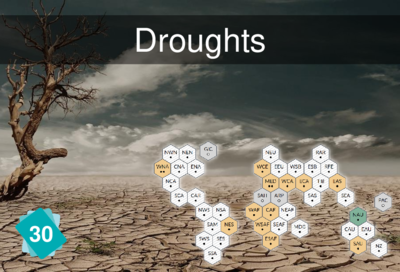En-en adult card 30 droughts
Card #30: Droughts
The disruption of the water cycle can both increase and decrease rainfall. A lack of rain can cause drought. Droughts are likely to become more frequent in the future.
Explanation
A drought is a period of abnormal water shortage. A meteorological drought is when there is a drop in rainfall, and an agricultural drought is when soil moisture drops abnormally, affecting crop production. A mega-drought is a persistent and widespread drought that lasts much longer than normal (usually a decade or more)[1].
Lack of rainfall and evaporation from the ground are the causes of droughts, as well as soil erosion.
Correction
Causes
Consequences
Other possible links
Other consequences
- Carbon sinks If a lack of rain occurs while plants are growing, there is less photosynthesis and therefore a reduction in capacity of the carbon sink. In Europe, in 2018, carbon sinks declined by 18%[2].
To go further
Occurrences of this phenomenon
Africa
The worst drought in Africa hit in 2020: according to the United Nations World Food Programme (WFP), 45 million people are in a situation of severe food insecurity. These include Mozambique, the Democratic Republic of Congo, Tanzania, Zambia and Zimbabwe[3].
Tree density is declining in the western Sahel and semi-arid Morocco, beyond the changes due to land use. (IPCC WG2 AR5)
Asia
In the 1960s, the Aral Sea was the fourth largest lake in the world, more than twice the size of Belgium (70,000km²)[4]. Today, it has almost disappeared: the Aral Sea has lost 75% of its surface area, 14 metres in depth and 90% of its volume[5], which has increased its salinity and caused the disappearance of most endemic species. The number of fish species has fallen from 32 to 6. Shipwrecks can be seen on the old seabed[6].
In India in 2009: the lowest rainy season since 1970 and the strong first year that rice imports have been necessary to feed its population since the late 1980s.
Decreasing soil moisture in central and northeast China (1950 -2006) (IPCC WG2 AR5 medium confidence, major contribution from climate change)
Europe
Appearance of desert landscapes in south-eastern Spain[7].
In France, since 2001, 670 natural disasters have been recorded in metropolitan France and the overseas departments. They have caused 15,539 deaths, 96% of which were due to the heatwave of 2003, and cost more than 10 billion euros in insured damage alone[8].
The drought of 2003 was the most costly in its history[9], affecting 8,000 French communes and having to push legislation to change its definition of natural disasters, because the drought led to landslides and made land totally uninhabitable.
Americas
In the United States, autumn 2012 saw the worst drought in 25 years: 80% of agricultural land was affected, with two-thirds of the farms affected, leading to 4% inflation in food prices in 2013. In 7 American states, agricultural yield statistics have highlighted a depletion of water resources ranging from 90% to 100% (Oklahoma, Wyoming, Kansas, Colorado, Dakota, Nebraska...).
References
- ↑ Glossary for Report 5, Working Group 1(French)
- ↑ https://www.icos-cp.eu/science-and-impact/science-contribution/success-stories/drought
- ↑ UN World Food Programme, Southern Africa: UN agencies call for more support for hungry people in the face of climate shocks (French)
- ↑ France 24, The death of the Aral Sea (Frech)
- ↑ Project INTAS-0511 REBASOWS, Database of the Aral Sea / Bathymetric characteristics
- ↑ The Educational Web, The Aral Sea, repairing a man-made disaster (French)
- ↑ Consoglobe, Desertification is gaining ground in Spain (French)
- ↑ Banque des Territoires Caisse des Dépôts et Consignations, Risks - 670 natural disasters causing more than 15,000 deaths since 2001 (French)
- ↑ Information Report No. 39 (2009-2010) by Mr. Jean-Claude FRÉCON and Mrs. Fabienne KELLER, made on behalf of the Finance Committee, Drought of 2003: a past that doesn't go by (French)
